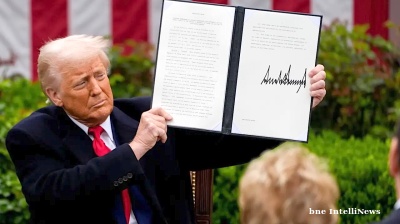Liberal Warsaw Mayor Rafał Trzaskowski and his radical right-wing rival Karol Nawrocki will each lead separate marches through the capital on May 25, as both candidates escalate their campaigns before Poland’s presidential run-off on June 1.
The two rallies will proceed along parallel routes in central Warsaw, just 600 metres apart, creating a tense backdrop to the final stretch of the campaign.
Trzaskowski’s team has labelled their event “The Great March of the Patriots,” while Nawrocki’s supporters will march under the banner “The Great March for Poland.”
“Let’s remember that every vote matters. It’s now or never,” deputy Defence Minister Cezary Tomczak, a close aide to Trzaskowski, said in an interview with Onet.
“Let’s show that we want a Poland that is ambitious, proud and safe. A Poland without illegal migrants. A Poland that respects citizens’ freedom. Without censorship and without Donald Tusk’s autocracy,” Nawrocki said in a video message.
Donald Tusk is prime minister of a four-party coalition government led by Civic Coalition, of which Trzaskowski is a deputy chairman.
Both candidates are now seeking to reach beyond their core electorates, aiming to expand support while holding on to loyal voters and discouraging mobilisation from their opponent’s base – all within just 10 days.
Trzaskowski faces a more difficult challenge. To win, he must appeal to both centre-left and far-right voters – two blocs with often irreconcilable demands. The far right is especially crucial after its leader, Sławomir Mentzen, secured nearly 15% of the vote in the first round on May 18.
Trzaskowski came out ahead with 31.4%, while Nawrocki followed closely with 29.5%.
Mentzen invited both finalists to appear on his YouTube channel and consider signing a declaration that includes pledges to block Ukraine’s NATO accession, reject the deployment of Polish troops to Ukraine and oppose any tax increases.
Nawrocki, who is backed by the opposition Law and Justice (PiS) party, joined Mentzen on May 22 for a 90-minute livestream. During the discussion, viewed by some 350,000 people, he aligned himself with most of Mentzen’s demands and even criticised the previous PiS government – an unusual move in Poland’s polarised political scene.
Trzaskowski is scheduled to meet Mentzen on May 24. He said he would first examine the contents of the declaration before making any commitments, signalling a cautious approach in navigating between competing voter groups.
His balancing act has become even more delicate since Adrian Zandberg, leader of the left-wing Razem party, gained nearly 5% in the first round. Zandberg positioned himself outside the Trzaskowski-Nawrocki divide, accusing both camps of neglecting social justice and workers’ rights.
While most of Zandberg’s nearly 1mn voters are expected to favour Trzaskowski in the run-off, Zandberg has withheld an explicit endorsement, stating that Trzaskowski must first offer credible policy proposals.
This position prompted criticism from some in the liberal camp, who accused Zandberg of aiding Nawrocki’s chances. Zandberg, in turn, attacked the longstanding dominance of both Civic Coalition and PiS, which have alternated in power since 2005.
Trzaskowski has tried to build bridges by restating his commitment to reproductive rights and LGBTQ+ protections, though he has largely avoided climate policy – a move likely aimed at not alienating potential swing voters from the right. However, this strategy may cost him support among progressive and younger voters.
The only direct clash between the two candidates will take place during a head-to-head debate on May 23. The format allows Trzaskowski and Nawrocki to question each other directly, with a moderator only enforcing time limits. The discussion will focus on six key topics: security, economy, social policy, foreign policy, health and ideology.
Observers say the debate and upcoming marches could be decisive. Voter turnout and mobilisation efforts may ultimately determine the outcome.
Trzaskowski’s position has become more precarious since the first round, when polls showed him leading Nawrocki by 6 to 10 points. Analysts also note that surveys underestimated the strength of the far-right vote.
The stakes are high. For Prime Minister Donald Tusk, a Trzaskowski victory would remove the current presidential veto, which has stalled his reform agenda.
But Tusk’s government, composed of four parties from across the ideological spectrum, faces internal tensions that may hamper its effectiveness even under a friendly president. That could prove disastrous in the next general election in 2027.
If Civic Coalition wins the presidency, Trzaskowski could serve as a counterweight to a possible right-wing comeback in 2027.
On the other hand, a Nawrocki victory would allow PiS to hold the presidency and obstruct Tusk’s policies, setting the stage for a campaign focused on the government’s ineptitude to reclaim full power.
News

European foreign ministers hit out at Georgian ruling party
Statement condemned ongoing democratic backsliding by the ruling Georgia Dream party, which has consolidated power via crackdowns on independent media, NGOs, activists and opposition politicians.
_1752493253.jpg)
RSF urges EU action over police violence against journalists in Serbia
Press freedom watchdog Reporters Without Borders warned abuses threaten the country’s EU accession process.

US and Panama launch joint military exercises amid canal security concerns
US helicopters have arrived in Panama to begin collaborative training exercises with local security forces, as tensions mount over the strategic waterway's future amid competing US and Chinese interests.

Migration pushes EU population to record high, but CEE countries continue to shrink
Immigration outweighed the natural population decline in 2024 in just three of the newer EU member states – Croatia, Czechia and Slovenia.



